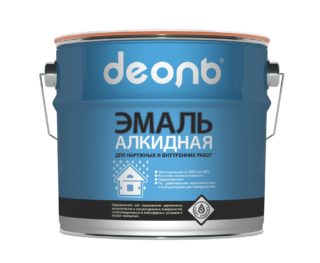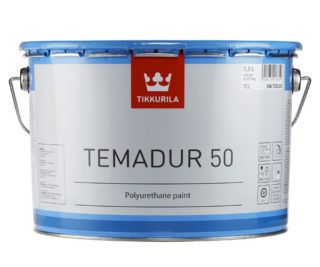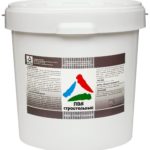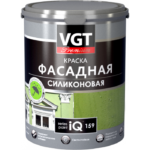The foundation is the foundation of the building, which requires reliable protection from external and internal negative factors. You need competent waterproofing and proper finishing. Basement base paint is a simple protection option that has a relatively low cost. There are different types of compounds, so before choosing, you need to consider their properties.
The importance and necessity of finishing the base

Painting the basement allows you to solve several important issues, but you need to choose the composition taking into account the climatic conditions and operating characteristics. It is also important to understand what this procedure is for:
- Many materials that are used for the construction of the foundation have a porous structure, so moisture can penetrate inside, destroying the structure.
- Concrete or brick is exposed to mechanical stress. The paint protects the base from damage.
- The above-ground part of the foundation is susceptible to rapid contamination, which deteriorates its appearance. Painting the surface will make it easier to maintain.
A concrete structure without proper finishing does not look very aesthetically pleasing. Processing with paint allows you to achieve decorativeness: the base will look neater, and minor construction flaws will not be visible.
Advantages and disadvantages of painting the basement base
Before choosing a suitable composition, you should consider the advantages and disadvantages of this finishing method. Plinth paint has the following advantages:
- decorativeness: most of the compositions have improved qualities;
- a variety of textures and a wide range of colors;
- affordable price for any buyer;
- improving the appearance of the base and extending its service life;
- ease of application (you can use manual and mechanical methods here);
- the ability to work with a wide range of humidity or temperature;
- the presence in the composition of paints of components that provide air permeability;
- the ability to change the appearance of the structure.
This finish fits into any exterior design style. However, the paint has some drawbacks: not all compositions are vapor-permeable and firmly adhere to the surface. High quality and durable mixes are expensive. For their application, preliminary preparation of the base is required.
Used coatings
Alkyd based
Alkyd compounds are more suitable for working with metal and wood substrates. They protect the surface from moisture and aggressive substances. The layer does not fade for a long time under the influence of ultraviolet radiation, but it will have to be periodically updated. The composition will reliably protect the base from mechanical damage, resistant to abrasion. Chemicals can be used to clean the surface.
Since the paint contains a solvent, you need to work with it in protective clothing, gloves and a respirator - the substance has a sharp unpleasant odor. Do not store them near open fires - alkyd mixtures ignite easily.
Polyurethane paints
To achieve the maximum effect, the composition is applied in several layers. The layer gains final strength in 1-2 weeks. The only drawback of such a foundation paint is the high price, although it pays off quickly.
Enamel
The enamel paint contains varnish, resin, as well as polymer components. Before use, it must be prepared: stir with a small amount of solvent. This finish is durable, resistant to moisture, and provides a beautiful glossy shine. The advantage of the product is the variety of colors. However, the mixture does not allow air to pass through well, so indoor humidity problems may arise.
If there is a risk of exposure to high temperatures on the plinth, it is better to use a fire retardant paint for the finish. It is suitable for metal surfaces. Such material must be stored correctly: in a dark, dry place.
Silicone compounds
For painting the basement of the house, it is optimal to use a silicone compound. It works best if the surface is finished with plaster. The coating layer turns out to be durable, reliably fixed on the surface, resistant to the influence of almost all negative factors. Silicone paint is elastic (it does not crack even when the building shrinks) and is capable of air permeability. The finish retains decorativeness and color for a long time, as it is resistant to the influence of ultraviolet radiation.
Polyvinyl acetate paints
Before painting the foundations with polyvinyl acetate paint, you need to dilute the mixture with water (it has an adhesive base). Such a composition is cheap, but the coating is not resistant to abrasion and precipitation. This material is used least often.
Pre-primer
Before painting the surface of the base, you need to treat it with a primer. After this procedure, the adhesion of the composition to the base will increase, and the decorative properties of the finish will improve. This preparation will reduce paint consumption. For apartment buildings located in industrial areas of cities, a mixture based on acrylic is suitable, which provides breathability and reliable protection.
If the structure is built in an ecologically safe region, then you can choose a water-dispersion solution. For porous materials, a special deep penetration soil must be selected. It is better to choose a protective and decorative composition from one manufacturer.
You can make a primer yourself. To do this, paint or enamel must be diluted with a solvent in a 10: 1 ratio. This compound is the first finish coat. Professional solutions are applied 1-2 times. In this case, the previous layer must dry completely.
Processing and painting technology

Before you paint your concrete foundation, you need to choose the right tool. For work, you need: cement (with its help, cracks and grooves are closed), a primer, a sealant, as well as a decorative composition. For application, you need a brush or roller (you can use a mechanical device), a container for paint, a stiff brush. You also need a shovel for excavation work and protective clothing.
The work includes the following stages:
- Preparation of the base.It is necessary to clean the foundation itself and dig in it. A metal brush is used to clean the surface, after which all cracks and chips are sealed. After the cement has dried, the base must be rinsed.
- Surface priming.
- Painting. More often than not, you will need to apply several layers of paint. This will improve the decorative and protective qualities of the coating.
If the outside area of the base is large, it is better to use a spray gun. In this case, the consumption of material may increase, but the time of work will be reduced.
Features of restoration work
Often, natural or artificial stone is used for facing the basement, but such decor is not cheap. If a new structure requires little preparation, then the old facade will have to be processed more carefully. Restoration is a laborious process. First, you will have to examine the base for the presence of exfoliated fragments. They are removed, and the chips are covered with cement mortar.
The surface is cleaned of dust, dirt, sagging, the base is primed. After drying, the base is painted with the selected composition. To do this, use a roller or a wide brush.
Modern paints for finishing the outer surface of the foundation have similar properties, but in each case it is necessary to select the optimal composition. Before purchasing the material, you need to carefully study the instructions for its use and further operation.













